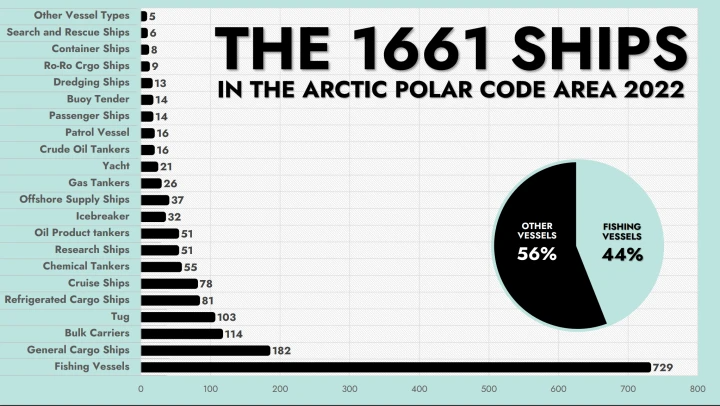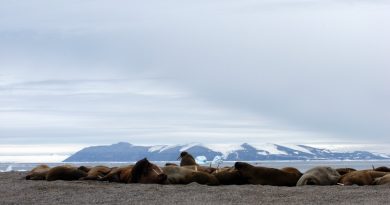Fishing vessels dominate Arctic shipping traffic in 2022: report

According to a recent Arctic Council report, fishing vessels were the most common ships in Arctic waters in 2022.
Of the 1661 unique vessels recorded in the Arctic Polar Code region, 729, or 44 per cent, were engaged in fishing activities.
“The majority of these (77 per cent) are vessels for catching fish whose method is other than trawling, such as long liners, purse seiners and others,” the Arctic Council’s Protection of the Arctic Marine Environment (PAME) report, released on Monday, said.
“Fish factory ships accounted for 20 percent of total fishing vessels, which includes trawlers and vessels fitted out with a factory for refrigerating, processing and possibly canning.”
Carriers, patrol vessels, research boats and seal catchers were the least frequent types of fishery-related boats, the report said.

The second most common category was cargo vessels, with a total of 182 of these ships recorded during the observed time period.
General cargo ships carrying dried goods with single or multi-decks made up 82 per cent of these boats. Deck cargo ships that transport unitized cargo, such as goods on pallets, make up the next biggest category, accounting for 15 per cent of total cargo ships.
The third largest category was bulk carriers, ships that transport things like iron ore, coal and grain.
Of these, 114 were counted in the Arctic in 2022.
“The majority of bulk carriers (94 per cent) were single deck cargo vessels with an arrangement of topside ballast tanks for the carriage of bulk dry cargo of a homogenous nature,” the report said.
“Six bulk carriers were ore/oil carriers constructed for the alternative carriage of crude oil.”
Exploring for natural resources is a main driver of Arctic shipping, the PAME report said. In 2022, vessels doing this work accounted for 18 per cent of unique ships in the Arctic:
- Bulk carriers, 114 ships
- Chemical tankers, 55 ships
- Oil product tankers, 51 ships
- Offshore supply ships, 29 ships
- Gas tankers, 26 ships
- Crude oil tankers, 16 ships
Source: “Types of ships operating in the Arctic,” PAME report
The report, “Types of ships operating in the Arctic,” is PAME’s fifth Arctic Shipping Status Report. The prior reports looked at subjects like flag states operating in the North, heavy fuel oil and other Arctic shipping trends.
PAME is one of the Arctic Council’s six working groups and is made up of international experts.The teams examine issues ranging from environmental protection, to sustainable development, to emergency response in the Arctic.
PAME created the Arctic Ship Traffic Database in response to the lack of recent info about Arctic shipping, even as an increasing number of vessels were sailing up North.
The database includes figures dating back to 2013.

Comments, tips or story ideas? Contact Eilís at eilis.quinn(at)cbc.ca
Related stories from around the North:
Related stories from around the North:
Canada: Canada comes out in favour of heavy fuel oil ban in Arctic, Eye on the Arctic
Finland: Finland investigates oil leak risks from Baltic Sea shipwrecks, Yle News
Greenland: Inuit work towards greater voice in shipping as IMO meeting gets underway, Eye on the Arctic
Iceland: Iceland to restrict heavy fuel oil use in territorial waters, Eye on the Arctic
Norway: LNG-reloading operations end in Norway’s Arctic waters, The Independent Barents Observer
Russia: Growth in Arctic shipping warrants Polar Code adjustments, say experts, Eye on the Arctic
United States: Carnival Corporation ships switch to cleaner fuel on Arctic cruises, Radio Canada International



